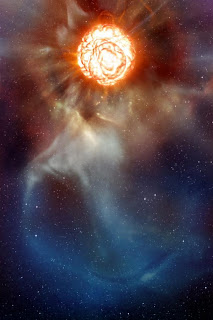According to the researchers, the star has swollen in size to become a red giant star so large that it would swallow every planet out to Mars in our solar system. The star has started to pulse dramatically beating like a giant heart, they stated.
As a sun-like star ages, it begins to run out of hydrogen fuel at its core. Like a car running out of gas, its "engine" begins to splutter, researchers said. On Chi Cygni, those sputterings are seen as a brightening and dimming, caused by the star's contraction and expansion, researchers stated.
Chi Cygni pulses once every 408 days, the scientists stated. . At its smallest diameter of 300 million miles, it becomes mottled with brilliant spots as massive plumes of hot plasma roil its surface. (Those spots are like the granules on our Sun's surface, but much larger.) As it expands, Chi Cygni cools and dims, growing to a diameter of 480 million miles - large enough to engulf and cook our solar system's asteroid belt, researchers said.
In order to see stars like Chi Cygni that are so far away the researchers used a technique called interferometry, which involves combining the light coming from several telescopes to yield resolution equivalent to a telescope as large as the distance between them.
In this case researchers used the Smithsonian Astrophysical Observatory's Infrared Optical Telescope Array, or IOTA, which was located at Whipple Observatory on Mount Hopkins, Arizona. The team also said it used amateur astronomer observations provided by the American Association of Variable Star Observers (AAVSO).

